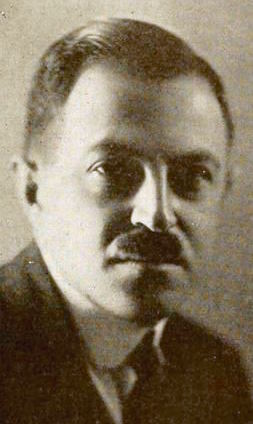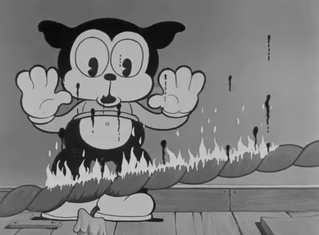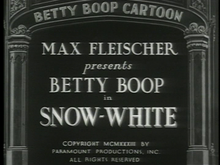
Fleischer Studios was an American animation studio founded in 1929 by brothers Max and Dave Fleischer, who ran the pioneering company from its inception until its acquisition by Paramount Pictures, the parent company and the distributor of its films. In its prime, Fleischer Studios was a premier producer of animated cartoons for theaters, with Walt Disney Productions being its chief competitor in the 1930s.

Max Fleischer was a Polish-American animator, inventor, film director and producer, and studio founder and owner. Born in Kraków, Poland, Fleischer immigrated to the United States where he became a pioneer in the development of the animated cartoon and served as the head of Fleischer Studios, which he co-founded with his younger brother Dave. He brought such comic characters as Koko the Clown, Betty Boop, Popeye, and Superman to the movie screen, and was responsible for several technological innovations, including the rotoscope, the "follow the bouncing ball" technique pioneered in the Ko-Ko Song Car-Tunes films, and the "stereoptical process". Film director Richard Fleischer was his son.

Betty Boop is an animated cartoon character created by Max Fleischer, with help from animators including Grim Natwick. She originally appeared in the Talkartoon and Betty Boop film series, which were produced by Fleischer Studios and released by Paramount Pictures. She was featured in 90 theatrical cartoons between 1930 and 1939. She has also been featured in comic strips and mass merchandising.

Talkartoons is a series of 42 animated cartoons produced by Fleischer Studios and distributed by Paramount Pictures between 1929 and 1932.

Koko the Clown is an animated cartoon character created by Max Fleischer. He first appeared as the main protagonist in Out of the Inkwell (1918–1929), a major animated series of the silent era. Throughout the series, he goes on many adventures with his canine companion "Fitz the Dog", who would later evolve into Bimbo in the Betty Boop cartoons.

Rotoscoping is an animation technique that animators use to trace over motion picture footage, frame by frame, to produce realistic action. Originally, live-action movie images were projected onto a glass panel and traced onto paper. This projection equipment is referred to as a rotoscope, developed by Austrian-American animator Max Fleischer. This device was eventually replaced by computers, but the process is still called rotoscoping.

Out of the Inkwell is an American animated film series of the silent era. It was produced by Max Fleischer from 1918 to 1929 and was called The Inkwell Imps at the end of that period.
"Minnie the Moocher" is a jazz-scat song first recorded in 1931 by Cab Calloway and His Orchestra, selling over a million copies. "Minnie the Moocher" is most famous for its nonsensical ad libbed ("scat") lyrics. In performances, Calloway would have the audience and the band members participate by repeating each scat phrase in a form of call and response, eventually making it too fast and complicated for the audience to replicate.

Myron "Grim" Natwick was an American artist, animator, and film director. Natwick is best known for drawing the Fleischer Studios' most popular character, Betty Boop.

Bimbo is a fat, black and white cartoon pup created by Fleischer Studios. He is most well known for his role in the Betty Boop cartoon series, where he featured as Betty's main love interest. A precursor design of Bimbo, originally named Fitz, first appeared in the Out of the Inkwell series.

The Old Man of the Mountain is a 1933 American pre-Code live-action/animated short in the Betty Boop series, produced by Fleischer Studios. Featuring music by Cab Calloway and his Orchestra, the short was originally released to theaters on August 4, 1933 by Paramount Pictures. Calloway voices all of the characters in the cartoon save for Betty herself. Calloway and his orchestra also perform all of the music in the cartoon, including two songs Calloway co-wrote.
Betty Boop's Bamboo Isle is a 1932 Fleischer Studios Betty Boop animated short, directed by Dave Fleischer.
Chess-Nuts is a 1932 Fleischer Studios animated short films starring Betty Boop, and featuring Bimbo and Koko the Clown.
Betty Boop's Museum is a 1932 Fleischer Studios animated short film starring Betty Boop, and featuring Koko the Clown and Bimbo.
Betty Boop's Ker-Choo is a 1932 Fleischer Studios animated short film starring Betty Boop, and featuring Koko the Clown and Bimbo.
Betty Boop's Penthouse is a 1933 Fleischer Studios animated short film featuring Betty Boop assisted by Koko the Clown and Bimbo.
Betty Boop's Birthday Party is a 1933 Fleischer Studio animated short film, starring Betty Boop and featuring Koko the Clown and Bimbo.
Roland Dimon "Doc" Crandall was an American animator. He is best known for his work at Fleischer Studio, especially on the Betty Boop version of Snow White and as lead animator with Seymour Kneitel on the first year of the "Popeye" the Sailor cartoons starting in 1933.

Bimbo's Initiation is a 1931 Fleischer Studios Talkartoon animated short film starring Bimbo and featuring an early version of Betty Boop with a dog's ears and nose. It was the final Betty Boop cartoon to be animated by the character's co-creator, Grim Natwick, prior to his departure for Ub Iwerks' studio.

Minnie the Moocher is a 1932 Betty Boop cartoon produced by Fleischer Studios and released by Paramount Pictures.










